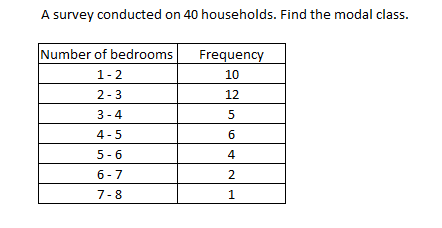10th Grade > Mathematics
STATISTICS MCQs
:
A
The median for grouped data is formed by l+(n2−cff ) ×h.
Where l is lower class limit of median class.
n is total number of observations.
cf is the cumulative frequency of the class preceding the median class.
f is the frequency of the median class and h is the class size.
:
C
Modal class is 4000-5000 within
f1 = 27, f0 = 21, f2 = 25, I = 4000, h = 1000
Mode = l + f1−f02f1−f0−f2×h
Mode = 4000 + 68×1000
= 4750
:
Modal Class is 200-300
Mode=I+(f1−f02f1−f0−f2)×h
=200+15−1130−11−9×100=240
:
A
Firstly, the cumulative frequency (CF) table is drawn.
C.ICFFrequency0−10121210−20301820−30572730−40772040−50941750−601006Total100
n2=1002=50
C.F nearest to 50 and greater than 50 is 57.
∴ Median=l+(n2−cff)×h
Where l is lower class limit of median class.
n is total number of observations.
cf is the cumulative frequency of the class preceding the median class.
f is the frequency of the median class and h is the class size.
Median=20+(50−3027)×10
Median = 27.4
:
A
The deviation is di=xi−A
:
C
The number of atheletes who completed the race in less than 14.6
= 2 + 4 + 5 + 71
= 82
:
B
Here we locate a class with the maximum frequency. From the given table we find the maximum frequency as 12 whose class is 2 - 3. Therefore the modal class is 2 - 3.
:
A
In statistics, 'the assumed mean' is a method for calculating the arithmetic mean and standard deviation of a data set. It simplifies calculating accurate values by hand.
During the application of the short-cut method for finding the mean, the deviation d, are divisible by a common number ‘h’. In this case, the di = xi – A is reduced to a great extent as 'di' becomes dih. In this method, we divide the deviations by the same number to simplify calculations. The deviation is di=xi−A
:
A
The median class is identified as the class whose cumulative frequency will be greater than n2, where 'n' is the sum of the frequencies. (n=200).
Next, we divide 200 by 2.
n2=2002=100
We now locate the class whose cumulative frequency is greater than 100.
"2500 - 3000" is the class whose cumulative frequency 155 is greater than 100.
∴The median class is 2500 - 3000.
{2, 20, 25, 17, 19, 22}
:
B
We know that extreme values in the data affect the mean. Here only for the data set {2, 20, 25, 17, 19, 22}, we find the extreme value as one class has the frequency as 2 and the others have frequency 20, 25, 17, 19 and 22.

















